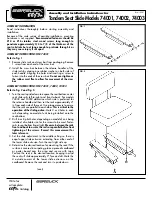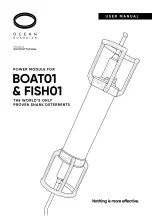
17
off the screw, it helps if you loosen the jaws off of the screw just enough to
break contact with the jaw faces). Next, turn the blank around and grip on
the spigot or the recess. You may wish to wrap some tape around your spigot
if damage from the chuck jaws is not acceptable. If you have turned a foot,
and want to ensure zero damage, you could also use a glue block at this point
(refer to Method 3). When holding by recess, damage will be negligible.
You are now ready to hollow the bowl.
METHOD 2
:
With a large drill or forstner bit, drill a hole to suitable diameter (2-3/8"
MINIMUM) and depth (1/4" or deeper) which acts as a recess. You can now
grip on this recess by expansion chucking and turn the outside of the bowl.
As in method one, turn a foot, a spigot, or a recess for holding. Loosen the
chuck, remove the blank, turn it around and now grip the blank on the back-
side and hollow out the bowl. This method is faster for larger quantities of
bowls, but the large hole requires a good drill press setup.
METHOD 3
:
A third method involves a glue block. Drill an 11/32" (9mm) hole in what
will be the inside of the bowl. Mount the jumbo screw in the chuck, and
thread the blank on the screw. Finish turn the outside of the bowl, and glue a
block to the bottom of the bowl. Turn the glue block round so it is concentric
and can be gripped in the chuck. Remove the blank from the Jumbo Screw,
and the Jumbo Screw from the chuck. You can then grip the glue block with
the Top Jaws, and hollow the inside of the bowl. Using a glue block is espe-
16
BOWLS AND PLATTERS:
There are many ways to hold your work piece for turning it into a bowl or
platter. Here are three good methods:
METHOD ONE
:
Mount the Jumbo Screw in your chuck. The base jaws should sit in the
grooves or flats which have been milled along the length of the head, and the
groove around the head of the screw will fit in the reduced top jaw section
(see page 6). (NOTE: No. 1 Jaws cannot be used with the Jumbo screw).
After the screw is seated properly in your chuck, drill an 11/32" (9 mm) hole
about 3/4" (19 mm) deep in the part of the wood blank which will be the
inside of the bowl when its finished. Thread the blank onto the screw, mak-
ing sure the face of the blank is in contact with the jaws. You may have to
lock your spindle if you are having trouble holding the chuck stationary
while threading the blank onto the screw. (Never forget to unlock your spin-
dle before starting up your lathe, and its a good idea to get into the habit of
never leaving your key in the chuck while you are doing something else).
Once your blank is mounted on the screw, you can rough or finish turn the
outside. To be able to mount your bowl for turning the second side, turn a
foot, a spigot or recess for holding. Now you can remove the blank from the
screw by rotating counter clockwise, (if you have trouble getting the blank
SECTION 5 - ONEWAY TURNING TIPS
This section of this instruction manual is devoted to turning tips, and ways to
maximize the use of your chuck.































